Gettysburg, October 2006
Page2
Photos/text courtesy of
Mick
Burkey, CA
Contact
Webmaster for
use of Mick's photos |
|
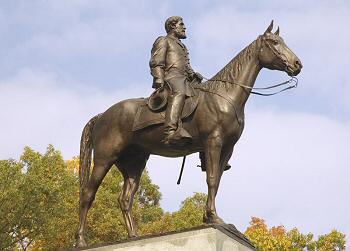 (10-06)
Enlarge
Statue of General Robert E. Lee and his horse, Traveller. The statue
sits atop the Virginia State Monument along West Confederate Avenue on
Seminary Ridge. Designed and sculpted by Frank Sievers, the statue was
created after Sievers had studied photographs and life masks of Lee done
shortly before the general's death in 1870. Sievers also inspected the
skeleton of Traveller, which was on display at Washington and Lee
University. A live horse, closely matching the size of Traveller, was
used as the actual model (10-06)
Enlarge
Statue of General Robert E. Lee and his horse, Traveller. The statue
sits atop the Virginia State Monument along West Confederate Avenue on
Seminary Ridge. Designed and sculpted by Frank Sievers, the statue was
created after Sievers had studied photographs and life masks of Lee done
shortly before the general's death in 1870. Sievers also inspected the
skeleton of Traveller, which was on display at Washington and Lee
University. A live horse, closely matching the size of Traveller, was
used as the actual model |
|
|
|
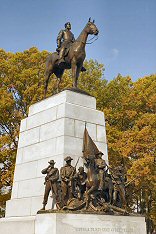 (10-06)
Enlarge The
Virginia State Monument, located along West
Confederate Avenue on Seminary Ridge, was the first of the Southern state
monuments placed at Gettysburg; dedicated June 8,1917. It is from this
spot that General Robert E. Lee observed portions of the battle. And it is
from near this spot, almost directly west of the Copse of Trees and The
Angle on Cemetery Ridge, that PickettÆs Charge began. The inscription on
the front of the monument reads: Virginia To Her Sons At Gettysburg (10-06)
Enlarge The
Virginia State Monument, located along West
Confederate Avenue on Seminary Ridge, was the first of the Southern state
monuments placed at Gettysburg; dedicated June 8,1917. It is from this
spot that General Robert E. Lee observed portions of the battle. And it is
from near this spot, almost directly west of the Copse of Trees and The
Angle on Cemetery Ridge, that PickettÆs Charge began. The inscription on
the front of the monument reads: Virginia To Her Sons At Gettysburg |
| |
|
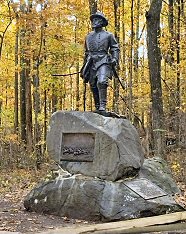 (10-06)
Enlarge Statue of Major William Wells, one of 63 men who received the Medal of
Honor for the Battle of Gettysburg. Soon after PickettÆs Charge on the
last day of the battle, Major Wells led the 1st Vermont Cavalry in
FarnsworthÆs Charge against LawÆs Alabama brigade. Farnsworth was killed
at the beginning of the charge, but Major Wells continued the charge and
engaged the Confederates in hand-to-hand combat. Though the assault
ultimately failed, it was one of the most daring charges of the battle.
Major Wells was eventually given Brevet Promotions to Brigadier General
on February 22, 1865, and Major General on March 13, 1865. He was
awarded the Metal of Honor on September 8, 1891 for "Most Distinguished
Gallantry at Gettysburg". He is also the lowest ranking officer who has
a statue at Gettysburg (10-06)
Enlarge Statue of Major William Wells, one of 63 men who received the Medal of
Honor for the Battle of Gettysburg. Soon after PickettÆs Charge on the
last day of the battle, Major Wells led the 1st Vermont Cavalry in
FarnsworthÆs Charge against LawÆs Alabama brigade. Farnsworth was killed
at the beginning of the charge, but Major Wells continued the charge and
engaged the Confederates in hand-to-hand combat. Though the assault
ultimately failed, it was one of the most daring charges of the battle.
Major Wells was eventually given Brevet Promotions to Brigadier General
on February 22, 1865, and Major General on March 13, 1865. He was
awarded the Metal of Honor on September 8, 1891 for "Most Distinguished
Gallantry at Gettysburg". He is also the lowest ranking officer who has
a statue at Gettysburg
On the front of the monument is a bas-relief of FarnsworthÆs Charge by
J. Otto Schweizer. The statue is on South Confederate Avenue, near Plum
Run where the charge began |
|
|
|
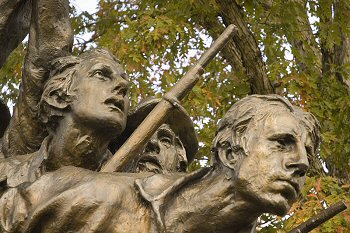 (10-06)
Enlarge Detail of the North Carolina Monument, located along West Confederate
Avenue on Seminary Ridge (10-06)
Enlarge Detail of the North Carolina Monument, located along West Confederate
Avenue on Seminary Ridge |
| |
|
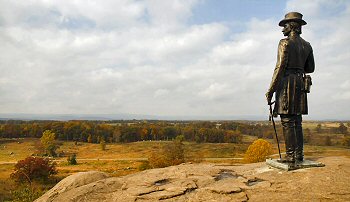 (10-06)
Enlarge View from Little Round Top looking west toward the Plum Run valley and
HauckÆs Ridge, the woods between The Wheatfield on the right and DevilÆs
Den to the left, out of picture. The statue on the right is Brigadier
General Gouverneur K. Warren, chief engineer of the Army of the Potomac.
On July 2, 1863, General Warren came to Little Round Top and found no
Federal troops save a few signalmen and observed that Dan Sickles had
not anchored the Federal left on the hill as ordered. Seeing Confederate
troops less than a mile away, and knowing the obvious crisis if they
took the heights, he sent aids to other commanders requesting troops to
solidify the left flank. This eventually led to Joshua ChamberlainÆs
famous and heroic charge down Little Round Top and the routing of
Alabama troops who had threatened the hill. For his actions, General
Warren is considered the savior of Little Round Top (10-06)
Enlarge View from Little Round Top looking west toward the Plum Run valley and
HauckÆs Ridge, the woods between The Wheatfield on the right and DevilÆs
Den to the left, out of picture. The statue on the right is Brigadier
General Gouverneur K. Warren, chief engineer of the Army of the Potomac.
On July 2, 1863, General Warren came to Little Round Top and found no
Federal troops save a few signalmen and observed that Dan Sickles had
not anchored the Federal left on the hill as ordered. Seeing Confederate
troops less than a mile away, and knowing the obvious crisis if they
took the heights, he sent aids to other commanders requesting troops to
solidify the left flank. This eventually led to Joshua ChamberlainÆs
famous and heroic charge down Little Round Top and the routing of
Alabama troops who had threatened the hill. For his actions, General
Warren is considered the savior of Little Round Top |